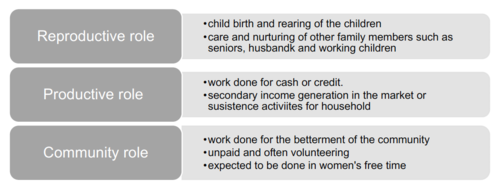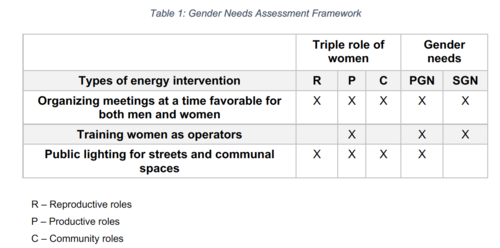Knowledge fuels change
For over a decade, Energypedia has shared free, reliable energy expertise with the world.
We’re now facing a serious funding gap.
Help keep this platform alive — your donation, big or small, truly matters!
Thank you for your support
Difference between revisions of "Gender Mainstreaming - Framework"
***** (***** | *****) m |
***** (***** | *****) |
||
| Line 57: | Line 57: | ||
=Harvard Analytical Framework= | =Harvard Analytical Framework= | ||
| + | This framework is also called Gender Roles Framework or Gender Assessment Framework. | ||
| + | |||
= Further Information = | = Further Information = | ||
Revision as of 17:49, 4 June 2020
Introduction
There are different frameworks for gender mainstreaming in projects such as Gender Needs Assessment Framework, Harvard Analytical Framework, Gender Analysis Matrix and the Capabilities and Vulnerabilities Analysis[1].
Gender Needs Assessment Framework
The Gender Needs Assessment framework is based on the triple role of women and the gender needs of women.
Triple Role of Women
Traditionally, the men are regarded as the “breadwinner” and the women as the “homemaker”. This is a very narrow definition as it fails to acknowledge the different roles and responsibilities of women[2]. The triple role (figure below) acknowledges the existing roles and responsibilities of the women and provides guidelines so that the gender mainstreaming activities align with the existing work of women and not create extra work for them[2]. The triple role of women are: Reproductive role, Productive role and Community Management role.
Reproductive Role
Women are the child bearers and are mostly responsible for nurturing and caring of the children. The reproductive role also extends to care of other family members such as the husband and the elderly members. This role is often seen as either “normal work” or not a “real work” and thus has a negative impact while talking about work and leisure time for women.
For example, when men get back from work, they can rest as their work outside the home is justified as “real work”. Women, on the other hand, are involved in carrying out all the domestic chores throughout the day but their work is not recognized as “real work”. Thus, they not only end up working longer but are often the last to get into bed after all the housework is done[2]. Because of the high importance of the reproductive role, women are likely to choose flexible works that allow them to look after their family esp. children and elderly members. The reproductive role also restricts their mobility and they are likely to look for work near their homes[3].
Productive Role
In many developing countries, women are not only involved in household duties but are also the secondary breadwinner of the family. The productive role refers to all activities that are done in exchange for cash or in-kind support. The activities could be for subsistence/home production or for selling in the market[2]. For example, women are also involved in subsistence farming. This saves the need to buy crops for their homes and also save money.
Community Management Role
This role refers to all activities done by the women for the betterment of the community. It is mostly unpaid and is done on a volunteering basis. It is expected to be done in women’s “free time” (after her reproductive and productive activities). Men, on the other hand, are often involved in authoritative community roles and get paid for their work[2]. For example, women’s groups are involved in forest management and water management often on a volunteering basis.
There are no clear demarcations between the different roles of the women and a gender mainstreaming activity can be a mix of all three roles. Nevertheless, the triple roles help to analyze the different roles of the women in the target community and to understand how the planned RE system can benefit women in their different roles.
Gender Needs of Women
As mentioned above, men and women have different roles and responsibilities in society and thus have different interests or needs called gender needs. Gender needs of women depend on their position in society and are influenced by the socioeconomic, cultural and religious factors. They are broadly categorized into two needs: Practical Gender Needs and Strategic Gender Needs[4].
Practical Gender Needs (PGN)
These refer to those practical needs that are identified by women in a particular context. Examples include: access to safe health care, sanitation, nutrition, safe drinking water and access to electricity[5]. PGN are the result of the prevalent gender roles and meeting PGN do not challenge the existing gender norms in society[4][6]. PGN can also be short-term goals.
Strategic Gender Need (SGN)
These are needs identified by the women due to their subordinate position in the society and vary from one society to another. Examples of SGN include: ending gender-based violence, improving access over resources and better legal rights. Addressing SGN is important to empower women and uplift their status in society. Meeting SGN is often a long-term goal[6][4]
The gender needs help to understand how the RE system is benefiting women i.e. is it meeting only the practical needs or is also uplifting the status of women in the society? The planned gender mainstreaming activities can be targeted to meet only PGN or both PGN and SGN.
Table 1 shows the Gender Needs Assessment framework including the triple roles and the needs of women[6][4]. Different activities are analyzed using the framework to show their impact on women’s roles and needs.
For example, organizing meetings at a time favorable to women acknowledges their triple roles and also encourge them to add their voices to the meeting. Thus it helps to meet the practical gender needs as well as empower them (SGN). Training women operators acknowledge their productive role and also meets their PGN and SGN. PGN could also be meet by providing access to electricity and SGN could be met by training women in societies where women are oppressed. Public lighting allows women to carry out all of their triple roles and they also make streets safer addressing SGN. Access to light is also a common PGN.
Harvard Analytical Framework
This framework is also called Gender Roles Framework or Gender Assessment Framework.
Further Information
References
- ↑ Berthaud, A., Delescluse, A., Deligiorgis, D., Kumar, K., Satoshi, S. M., Waafas, M., … Yee, S. M.(2004). Integrating gender in energy provision: Case study of Bangladesh. Retrieved fromhttp://documents.worldbank.org/curated/en/260121468742527534/pdf/30214.pdf
- ↑ 2.0 2.1 2.2 2.3 2.4 Moser, C. O. N. (1989). Gender planning in the third world: Meeting practical and strategic gender needs.World Development, 17(11), 1799–1825. Retrieved fromhttps://www.sciencedirect.com/science/article/pii/0305750X89902015
- ↑ Pueyo, A., & Maestre, M. (2019). Linking energy access, gender and poverty: A review of the literatureon productive uses of energy. Energy Research and Social Science, 53, 170–181. Retrieved fromhttps://www.sciencedirect.com/science/article/pii/S2214629618306145
- ↑ 4.0 4.1 4.2 4.3 Moser, C. O. N. (1989). Gender planning in the third world: Meeting practical and strategic gender needs.World Development, 17(11), 1799–1825. Retrieved fromhttps://www.sciencedirect.com/science/article/pii/0305750X89902015
- ↑ Olubukola, F. O. (2012). Participation of women in the csdp water project facilitated by the Kwara Statecommunity and social development agency (kwcsda): A study of bada ajegunle community inIfelodun local government area of Kwara State, Nigeria. Retrieved fromhttps://edepot.wur.nl/298465
- ↑ 6.0 6.1 6.2 Khamati-Njenga, B., & Clancy, J. (2003b). Concepts and Issues in Gender and Energy. Retrieved fromhttps://www.researchgate.net/publication/254860437_Concepts_and_issues_in_gender_and_energy





















